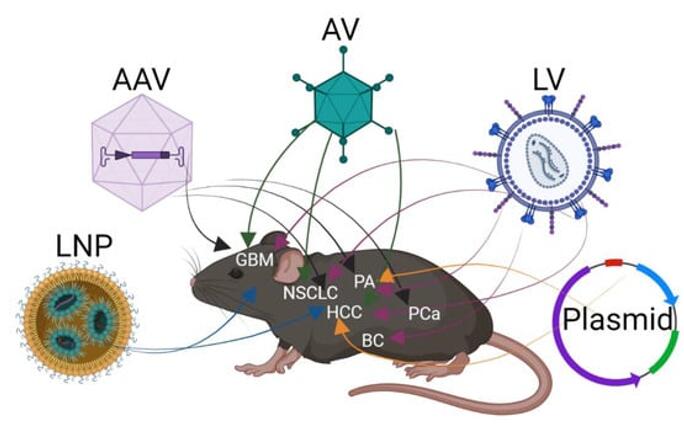
Our promise to you:
Guaranteed product quality, expert customer support.
 24x7 CUSTOMER SERVICE
24x7 CUSTOMER SERVICE
 CONTACT US TO ORDER
CONTACT US TO ORDER
CRISPR Mouse for Cancer Modeling 
Although overall cancer mortality continues to decline, it is still the leading cause of death, in part because of our limited understanding of the underlying biology of many cancer types. Understanding cancer biology requires new and rapid in vivo modeling approaches. The use of existing mouse models in cancer research is critical because they are designed to explore the causal link between candidate cancer genes and oncogenic effects and to provide models to develop and test new therapies. In contrast, CRISPR/Cas9 has revolutionized the cancer mouse model. In cancer, genetically engineered mouse models decipher biology by integrating molecular mechanisms, cellular processes, and environmental signals. Breakthroughs in gene editing are now driving major advances in mouse genetics, which opens new avenues for rapid model generation.
 Fig. 1 Delivery of CRISPR/Cas to induce cancer in the mouse. (Thomsen MK, 2022)
Fig. 1 Delivery of CRISPR/Cas to induce cancer in the mouse. (Thomsen MK, 2022)
Solution
CRISPR/Cas9 PlatformCB performs knockout/knock-in programs using the CRISPR/Cas9 system, ranging from sgRNA design and construction, prokaryotic microinjection to Founders genotyping and breeding. We are committed to providing knockout mice and knock-in mouse generation services to our customers. With experienced scientists and an excellent gene editing platform, our staff has successfully bred a wide range of gene KO mice as well as knock-in mice for cancer research using CRISPR/Cas9, including but not limited to
- Leukemia mouse models (targeted genes: TET2, DNMT3A , RUNX1 , NF1, EZH2, Mll3)
- Non-small cell lung cancer mouse models (targeted genes: p53 and Lkb1, Kras, Nkx2.1, Pten, Apc Eml4-Alk)
- Lymphoma mouse models (targeted genes: Mcl-1, p53)
- Hepatocellular carcinoma mouse models (targeted genes: Pten, p53 and β-catenin)
- Colon cancer mouse models (targeted genes: p53, Apc, Pten)
- Pancreatic ductal adenocarcinoma mouse models (targeted genes: Trp53, Lkb1 and Arid1A)
Note: We offer a wide variety of off-the-shelf cancer gene editing mouse models, and can also customize models to suit your research objectives. Please contact us by email for more updates and relevant information.
Our Approaches
- Infection of mouse embryos at different developmental stages by retrovirus
- Microinjection of DNA constructs or, more recently, nucleic acid endonuclease-based reagents directly into the protoplast of fertilized mouse oocytes.
- Gene-targeted gene editing methods, which include targeting mouse embryonic stem (ES) cells at selected sites by primarily introducing loss-of-function mutations, followed by microinjection of gene editing ES cells into mouse blastocysts and transfer to sham-pregnant recipient mice.
What Can We Help You?
- Study of complex biology, such as intercellular communication in the tumor microenvironment, or the multistep, multi-organ nature of metastasis
- Modeling tumor heterogeneity, tumor microenvironment, and tumor-stromal/immune cell interactions
- Evaluate investigational cancer therapies, especially new immunotherapies
- Exploring drug therapy and drug resistance
- Studying loss-of-function mutations in potential oncogenes
Related Services
- Conditional Knockout Mouse
- Conventional Knockout Mouse
- Point Mutation Mouse
- CRISPR/Cas9 Knockin Mouse
- Rosa26 Knockin Mouse
Related Products
Reference:
- Thomsen MK. Application of CRISPR for In Vivo Mouse Cancer Studies. Cancers (Basel). 2022, 14(20):5014.